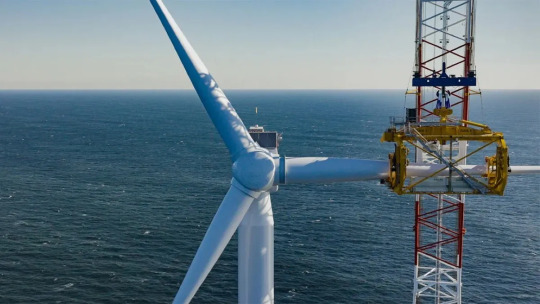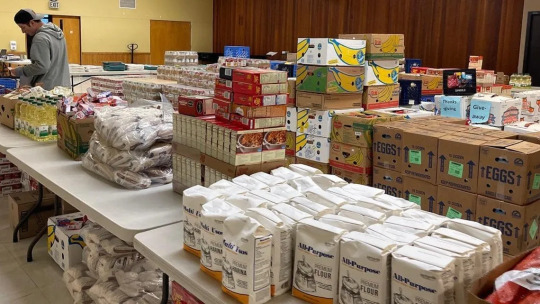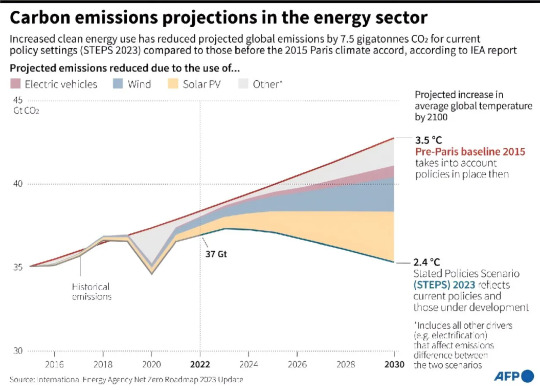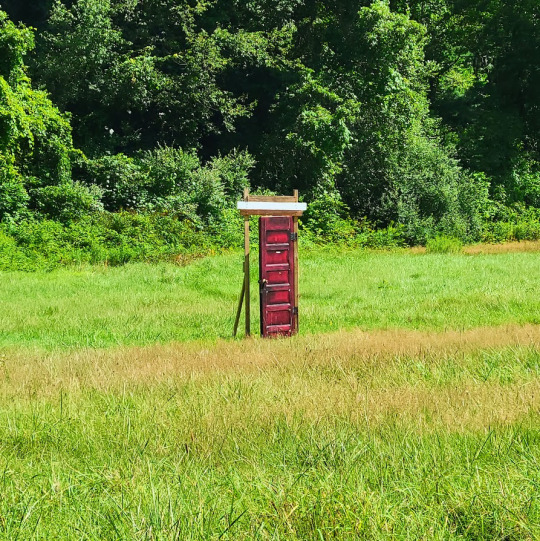#large-scale solar installations
Explore tagged Tumblr posts
Text
#technology#mw solar project provider#mw solar panel arrays#utility-scale solar projects#large-scale solar installations#solar epc services#solar epc provider#solar epc provider company#solar epc services provider#solar epc services provider company
0 notes
Text
[ABC is Australian State Media]
While Australia debates the merits of going nuclear and frustration grows over the slower-than-needed rollout of solar and wind power, China is going all in on renewables.
New figures show the pace of its clean energy transition is roughly the equivalent of installing five large-scale nuclear power plants worth of renewables every week.
A report by Sydney-based think tank Climate Energy Finance (CEF) said China was installing renewables so rapidly it would meet its end-of-2030 target by the end of this month — or 6.5 years early.
It's installing at least 10 gigawatts of wind and solar generation capacity every fortnight.
By comparison, experts have said the Coalition's plan to build seven nuclear power plants would add fewer than 10GW of generation capacity to the grid sometime after 2035.[...]
Smart Energy Council CEO John Grimes, who recently returned from a Shanghai energy conference, said China has decarbonised its grid almost as quickly as Australia, despite having a much harder task due to the scale of its energy demand.
"They have clear targets and every part of their government is harnessed to deliver the plan," he said.
China accounts for about a third of the world's greenhouse gas emissions. A recent drop in emissions (the first since relaxing COVID-19 restrictions), combined with the decarbonisation of the power grid, may mean the country's emissions have peaked.
"With the power sector going green, emissions are set to plateau and then progressively fall towards 2030 and beyond," CEF China energy policy analyst Xuyang Dong said.[...]
The world's largest solar and wind farms are being built on the western edge of the country and connected to the east via the world's longest high-voltage transmission lines.[...]
Renewables have a "capacity factor" (the ratio of actual output to maximum potential generation) of about 25 per cent, whereas nuclear's is as high as 90 per cent.
So although China is installing solar and wind generation equivalent to five large nuclear power plants per week, their output is closer to one nuclear plant per week.[...]
To "firm" or stabilise the supply of power from its renewable energy zones, China is using a mix of pumped hydro and battery storage, similar to Australia.
"They're installing 1GW per month of pumped hydro storage," Mr Buckley said.
"We're struggling to build the 2GW Snowy 2.0 in 10 years."[...]
The China Energy Council estimated renewables generation would overtake coal by the end of this year.
The CEF's Xuyang Dong said despite the country's reliance on coal, "having China go green at this speed and scale provides the world with a textbook to do the same".[...]
"In China they decide they're going to do something and then they go and do it."
15 Jul 24
767 notes
·
View notes
Text
The Best News of Last Week - November 28, 2023
🐑 - Why did Fiona the sheep become a mountaineer? She was tired of the "baa-d" jokes at sea level!
1. Pope Francis dines with transgender women for Vatican luncheon

Pope Francis hosted a group of transgender women — many of whom are sex workers or migrants from Latin America — to a Vatican luncheon for the Catholic Church's "World Day of the Poor" last week.
The pontiff and the transgender women have formed a close relationship since the pope came to their aid during the COVID-19 pandemic, when they were unable to work. Now, they meet monthly for VIP visits with the pope and receive medicine, money and shampoo any day, according to The Associated Press.
2. New York just installed its first offshore wind turbine

The first wind turbine installation at South Fork Wind, New York State’s first offshore wind farm, is complete.
The 130-megawatt (MW) South Fork Wind will be the US’s first completed utility-scale wind farm in federal waters.
3. Anonymous businessman donates $800k to struggling food bank

But this Thanksgiving, a longtime prayer of food bank leaders was finally answered: an anonymous benefactor donated the full $800,000 they needed to move out of a facility they've long outgrown. That benefactor, however, preferred to stay anonymous.
"Very private company, really don't want attention," said Debbie Christian, executive director of the Auburn Food Bank. "It's a goodhearted person that just wants to see the work here continue, wants to see it expand."
4. Empowering woman saving hopes and mental health of suffering Ukrainian kids

Kenza Hadij-Brahim is at the forefront of promoting Circle of Toys
Hadj-Brahim is helping to launch the Circle of Toys initiative. A project that provides Ukrainian children in need of some normality with preloved toys. This new initiative connects people with old toys they might otherwise throw away, with Ukrainian families in need who want to provide some comfort to their children in this distressing time.
Find Refuge said : “The endeavour is driven by a sincere purpose: spark joy, foster play, and bring a hint of normalcy back to the young lives in Ukraine.”
5. TWO LOST CITIES HIDDEN FOR CENTURIES WERE JUST DISCOVERED IN BOLIVIA

Researchers have found these areas not only housed structures and pyramids but it has been uncovered that there were advanced irrigation systems, earthworks, large towns, causeways, and canals that cover miles.
Dr. Heiko Prümers from the German Archaeological Institute, who was also involved in the study comments that “this indicated a relatively dense settlement in pre-Hispanic times. Our goal was to conduct basic research and trace the settlements and life there. The research sheds light on the sheer magnitude and magnificence of the civic-ceremonial centers found buried in the forest”.
6. Sheep dubbed Fiona rescued from cliff in Scotland where she was stuck for more than 2 years
youtube
And at last, some positive climate news:
7. Three positive climate developments

Heating
When the Paris Agreement was adopted, the global reliance on fossil fuels placed the world on a path towards a 3.5C rise in temperature by 2100. Eight years on, country commitments to reduce their carbon footprints have pulled that down slightly, putting the world on a path for a 2.5C to 2.9C by the end of the century.
Peak emissions
Annual greenhouse gas emissions responsible for climate change have risen roughly nine percent since COP21, according to UN data. But the rate of the increase has slowed significantly. Recent estimates by the Climate Analytics institute find global emissions could peak by 2024
Rising renewables
Three technologies—solar, wind and electric vehicles—are largely behind the improved global warming estimates since 2015.
---
That's it for this week :)
This newsletter will always be free. If you liked this post you can support me with a small kofi donation here:
Buy me a coffee ❤️
Also don’t forget to reblog this post with your friends.
815 notes
·
View notes
Text
how the writing is going
Ok so. LOL. About the only thing I am effectively achieving this week *is* writing, and even that is not really..... I don't have a draft. But I have a whole bunch of sample snippets I've written to try and feel my way through the worldbuilding and discover the sorts of things the characters are likely to be preoccupied with, which is often how I figure out what a plot should be.
The next thing I thought about after dolphins was modes of transport besides sailing ships.
So this is a fairly high-tech society, but they do not have fossil fuels, and they don't have a large-scale power grid. I decided that for aesthetics, but as I'm unpicking my plot, I'm realizing that it makes sense. See, the main driver for all my plot devices is that there's a lot of sun activity-- sunspots, coronal mass ejections, magnetic field anomalies, that sort of shit. A power grid could not survive on a large scale. So all power generation is done in small, local installations-- some very local indeed, panels on rooftops, little waterwheels, tiny wind turbines. Industrial-scale power is generated in hydro plants and used right at the site for hydro-powered manufacturing-- much of it direct hydro-power, not converted to electricity. Just direct drive waterwheel shit. Because the sun can throw whatever shit it wants at the planet and your waterwheel won't notice or care.
That said. Communication over long ranges does pose a significant challenge. You're going to need line-of-sight semaphores and shit, which I had not worldbuilt in the earlier versions but absolutely could add in.
There should be trains, and I haven't really pondered those yet because I need to know more about my geography. Please, god, don't make me draw a map, but I'm gonna have to. Oh well.
But the other thing I thought of and got really excited about was
DIRIGIBLES
It's feasible with technology we currently have, and this is a thing that some large companies are pursuing, to make very large, hydrogen-filled, entirely solar-powered dirigibles for long-distance cargo transportation, faster than ships, the same speed as trucks/trains but more direct, slower than airplanes but INFINITELY lower carbon footprint. And hydrogen is outlawed by the FAA as a lifting gas, not because of the Hindenberg (which had many contributing factors) but because of a Congressional hearing which was presented by the helium lobby in the 20s. Hmmmmm.
A fascinating detail is that you could make a solar-powered lighter-than-air craft operate day and night seamlessly by having a power generation process where some of the day's collected solar energy directly powers the thing, and some of it goes toward... I forget the details but it powers a chemical reaction that, come nightfall, is simply set to reverse itself, which will then release most of the energy that it took to power the reaction in the first place, which you can now use to power your aircraft. Which is not a thing I knew about and I now have to research how that would work because, fascinating.
Anyway. In Fantasy World, there are totally dirigibles, and they're also probably operated by the Navy, and the water-ship sailors fucking hate them, LOL. This will be a wildly entertaining dynamic and I am rubbing my little paws together.
Also.
While feeling sort of brain-dead and stupid, I got a sheet of paper, went through a bunch of lists of historic names and lists of like, suggested baby names from various ethnicities, and I just made lists on this sheet of paper of men's names, women's names, arguably gender-neutral names, and then a huge pile of surnames, and then I sat down with a bullet-pointed list cribbed from the website of the museum of the USS Constitution of all the personnel that would be on a 44-gun frigate ca. 1812, and I first pondered each of the jobs, added some, took some away, came up with my own numbers of how many guys I needed, and then I just sat there and combined the first and last names in aesthetically pleasing ways to generate characters, lightly crossing out ones I'd used. (and sometimes googling them to make sure they're not somebody famous or something, which i always recommend with fictional character creation, especially if you're as oblivious as I am.)
I was unable to resist also coming up with some backstories-- siblings, little work histories, criminal pasts, notable traits, that sort of thing-- for many of the characters.
I did not make up names for every individual person on this ship, which I decided should have a crew of about 150-180, but I made up some names for every position, and considered age and gender as well for all of them.
I will not use many of the characters I've created this way, I'm sure, but the ones with interrelationships will totally somehow get used, and this way as I'm writing if I need a character I can find them already made, and if that person has a defined role, I already know which one and won't lose track of them.
This also got me to consider why people wind up in the jobs they do in this society, what drives them to seek out certain things, and that gave me a lot of background as to what's going on onshore.
I should try to find a list of a dirigible's crew and think about them, too, and build out the train people and routes and whatnot.
I also bought a used older edition on Thriftbooks of The Annapolis Book Of Seamanship and have been reading that with... more interest than I expected actually. I have the 1983 edition and it has a really moving little plea to let the women on your ship also learn to sail because it is foolish to relegate them to the kitchen when if only they were taught how it works, they could save you all in an emergency. LOL I wonder if that's worded differently in the updated new version or not.
24 notes
·
View notes
Text
For years, banks have been financing large renewable power projects, from utility-scale solar farms to horizon-spanning wind farms. But smaller projects, like installing a heat pump in someone’s home or retrofitting affordable housing, often get passed over. They simply haven’t been lucrative enough. But the demand is there, which is why advocates have been clamoring for the federal government to support a so-called green bank, which will underwrite these sorts of projects. That green bank is now a reality. On Thursday, the EPA announced that it had awarded $20 billion in grants from the Inflation Reduction Act to eight organizations that will use the money to make loans that will help with those projects.
Continue Reading.
90 notes
·
View notes
Text
Bargains at the Space Market
This was, by far, the sleaziest place we’d stopped for supplies. At least while I’d been part of the crew. For all I knew, the upstanding little courier starship had visited some real dives under previous leadership, but Captain Sunlight was both respectable and smart.
I wondered whose idea it was to stop at this freewheeling anarchy market, set up on an asteroid that somebody had installed a gravity generator on. There was an atmosphere too, and a wide variety of stalls on this mile-long hunk of rock, but not much in the way of oversight.
I saw two different fistfights in progress among the other ships while we exited onto the landing pad.
“Okay,” announced Captain Sunlight, standing as tall as she could — which wasn’t much, lizardy little thing that she was, but she looked dignified — “Mimi, Blip, and Blop, come with me. Trrili, take one or two others with you. Anyone else object to staying to guard the ship?”
There was a hearty chorus of no’s. Zhee turned a faceted eye on the pair of bystanders walking a little too close, clicking his pincher arms at them until they scooted away. In the distance, something that looked like fireworks colored the sky.
A polite claw tapped my elbow.
“Want to come with?” asked Coals, the Heatseeker with dull red scales. He was both shorter and stockier than the captain, and more importantly, he was good friends with Trrili. “It’s a pretty interesting place; I’ve been here once before.”
“How safe is it?” I asked, wanting to be convinced. There were some bizarre things for sale in the stalls visible from here.
“Should be fine as long as we’re careful,” he said. “Especially with her around.” He lifted his chin towards the insectile horror that loomed over him.
Trrili loved looming. “Yessss,” she said. “Essspessssially with me.” She flexed her own pinchers, glossy black to Zhee’s purple, and chuckled darkly. The red patterns on her carapace were especially vivid in the light of the nearby sun.
I smiled. Trrili was terrifying, but she was our terrifying. “Sure. I’d love to come.”
Coals aimed a claw in the opposite direction of the one that Captain Sunlight was looking towards. “Pretty sure I saw some Earth animals for sale as we landed.”
“Oh, well why didn’t you say so?” I asked. “Lead the way!”
We checked in with the captain, promised to be careful, and were off. I had some interplanetary credits in my pocket that I didn’t really plan on spending, but it was good to be prepared.
I also had a mini stun gun in a different pocket.
This place was just as chaotic as I’d expected, like an alien farmer’s market with a distinct lowlife element. Here was a humanoid selling pottery that glowed; there was a tentacle alien selling food that moved; over there was a would-be pickpocket getting the tar beaten out of them by a large hairy whatsit. A hand appeared around the corner of another stall to grab a power cell and disappear.
I kept my own hands close to my pockets, wishing I’d worn something with zipper pouches.
“Ah,” said Trrili. “There is the media.” She didn’t bother hissing in normal conversation, but as she led us over to a booth lined with shelves and run by small individuals, I fully expected the intimidation to come out soon.
Just before we reached it, Coals rapped a knuckle on her foreleg. “Hey. We’ll be at the end of the row. See?” He pointed.
“Yessss,” Trrili agreed.
With a nod, Coals left her to her bargaining, and waved me onward. I was a little concerned about this, but the end of the row wasn’t far. We could yell for her to come charging over if need be.
“See those guys in the solar ponchos?” Coals asked. He didn’t need to point.
I squinted. “Hard not to.” The clothes that the two plant-like people wore weren’t as bright as the actual sun, but they sure were unpleasant to look at. The other shopkeepers were giving them some distance, leaving space between their little cart and the proper stalls. Aside from the eye-searing fashion, they had ropy green limbs and faces like rose blossoms that wanted to be mandibles. Fleshy maroon, sharptoothed mouth in the middle, at least half a dozen eyes scattered throughout. More than a little creepy.
“I was watching with the mag lens earlier,” Coals said. “With the classification setting. They’ve got the Earth animals.” He was watching my face as he said it.
The series of expressions that I went through were probably interesting to see as I got a proper look at what was on that cart.
Earth animals, yay! Which ones? Those look like fishbowls. But there’s no water inside, just … fur? Are those cats shoved in fishbowls??
I felt my face grow stony. “Coals,” I said. “Who do we report animal cruelty to around here?” One of the plant guys was waving a bowl around, shouting about potted predators. A passerby turned him down, and he yelled an insult after them.
“Uh, nobody.”
I watched the guy hold up a different one and say something about food paste squeezed in through the lid. When he flipped the cap to demonstrate, piteous mewling filtered out. “What about theft?” I asked.
“Also no.”
“Good,” I said, voice flat. “Go get Trrili, then help me steal these.”
* * *
It took less convincing than I thought. Trrili already had her selection of media in a bag slung behind her, and she chuckled evilly. Coals cracked his knuckles and talked strategy. Then we went for it.
“Hello,” I said, approaching the sellers alone. “How many of these do you have?”
“Everything on this cart,” said the taller one with the bigger blossom head. “Limited supply, very valuable; get them before they’re gone.” He picked up a fishbowl full of gray fur, turning it like a fine art appreciator. A tiny face with big eyes peered out, meowing silently. Stars, these were kittens.
“You don’t have a source for more?” I asked, trying to sound unimpressed.
“These are very exotic, from a far away planet,” he said.
The shorter one bent to pull a big bowl from the bottom shelf of the cart. “Perhaps we can interest you in a larger model? It’s one of a kind.”
That’s the mother cat. Good. I straightened up. “I’ll take all of them,” I said. “Every one you have.”
The sleazy pair chortled and fawned and named a price that could have bought a single-seater spaceship.
I pulled out my tiny stun gun and aimed it at the tall one. “No. I’ll just be taking them.”
They of course laughed at me, and pulled out their own weapons, which Coals had spotted and identified through the holsters. These were also stun guns, but a bigger and more painful model that put mine to shame.
They weren’t, however, very effective on people with exoskeletons.
Trrili leapt out from behind the nearest stall, crossing the distance in a heartbeat of flashing black-and-red limbs, then reared up to stand over them with her pinchers flared, shrieking at earsplitting volume.
I’d already ducked to the side, so while they stumbled back and aimed, I got a great view of Coals jumping forward to grab their stupid ponchos and yank them off their feet.
One of them shot Trrili in the foreleg, making her hiss a little, but the other didn’t even manage that. And before I could use my little peashooter, Coals had tackled them and wrestled the guns from both. With an oversized stun gun in each hand, he got to his feet and aimed at the pair, just daring them to try something, like the three-foot-tall badass he was.
“What did we do to you??” asked the tall one, rubbing his wrist but otherwise holding still.
“Yeah, how did we piss you off?” the smaller one demanded, eyes locked on Trrili.
I stepped forward with anger in my voice. “You didn’t offend either of them,” I said. “You offended me.” At their baffled silence, I continued. “Where did you get these animals? And what makes you think it’s okay to keep them contained like that?”
They both answered at once, and neither was terribly helpful. Some space trader somewhere. They didn’t even know where the cats were from.
“They’re from my planet,” I informed them. “And they should never be treated like this. Any human can tell you that.”
Their answer was just mumbling that sounded like “Yeah, okay.”
“Have you ever met a human before?” I asked, stepping closer. I leaned in. “My people eat things that look like you.”
They held very still, and didn’t object when Trrili pulled their cart away. Coals stepped back to follow, stun guns still aimed.
I put mine back in my pocket and gave them a final glare. “Do not try this again,” I said. “Or I will know.” I turned on my heel and followed Trrili, with Coals bringing up the rear. He kept the guns.
Shopkeepers and bystanders watched in curiosity, but none seemed particularly bothered by any of that. I heard what sounded distinctly like laughter. As we walked away, the hustle and bustle that had quieted a bit gradually resumed its normal volume.
I took the cart handle from Trrili. “Thank you both.”
Trrili chuckled. “My pleassurrrre.”
“Yeah, happy to help,” Coals said, moving up to walk alongside. He looked over the half dozen bowls that were rattling a bit, though I tried to pull the janky cart smoothly. “When you said you’d know…”
I held my chin up. “As far as they can tell, I will,” I said. “Any psychic abilities on the part of humans is for them to worry about.”
Coals laughed quietly and found the safety settings for the stun guns, saying nothing.
We got the cart into the ship without any objection from the crewmates we passed, though there was a fair amount of curiosity. Trrili and Coals stopped to tell the story in the lounge while I made a beeline for the medbay.
“I require use of your scanners,” I told Eggskin, who was understandably surprised. But at the sight of the cats, they wasted no time in bringing out everything required for a full checkup. I made sure to scan for contagion first, cart and all. I certainly didn’t trust those sleazeballs to be sanitary.
“All clear,” Eggskin said. They pulled gloves on over yellow-green scales. “Do we have spare carrying crates in the storage hold?”
“Oh, good point. We should put the family together.” I opened the door and leaned into the hallway. “Hey, Mur! Could you please bring a mid-size carrying crate? It’s urgent.”
Mur had been going a different direction, but he turned readily on dark blue tentacles with a “Sure thing.”
“Thank you!” I called after him.
He was back in no time with the crate, an ideal size for us to put Mama Cat into after her scan. She was dehydrated, but didn’t show any signs of having been in there long. Good. A bit of proper food and a reunion ought to be just the thing.
When we put the first kitten in with her, the purring was so loud it brought tears to my eyes. Eggskin and I wasted no time in checking the others. They were all okay. Not even any fleas.
I was talking with Eggskin about where to keep them for the time being when the door opened to let Captain Sunlight in. A curious crowd waited in the hall.
I stood at attention. “I’m not apologizing,” I said over the tiny kitten mews.
She shook her head. “No, I don’t expect you to. Are you hoping to keep them onboard, though?”
I shook my head. “I’m sure I can find a home for them at the next space station. Anywhere with a lot of humans, really. These are little cuties, and the mom didn’t even hiss at me, so she ought to raise them to be friendly.”
Captain Sunlight nodded. “All right, then. How about you keep them in your quarters as soon as they’re clear to leave the medical bay?”
“Yes, I was thinking that would be best,” I said. “I’ll just have to be careful opening the door. Maybe I can rig a net as a barrier that I can step over, to at least slow them down.”
“I’ll leave you to figure out how to keep them from roaming the halls,” she said. “Or the engine room, or the cockpit.”
“Yes. I will.”
She left it at that, and opened the door to shoo people away from the convalescing animals. The cart was already out there with the empty bowls and the food paste that would be going in the kitchen trash.
I saw Paint rummaging around the miscellaneous junk on the lowest shelf, which I hadn’t bothered to touch. Her orange tail straightened with excitement. “Hey, there’s money in here!”
I winced. Captain Sunlight gave me an unreadable look.
I felt bad about it, but then I looked down at the kittens tumbling over their mother, each getting licked in turn, and the feeling vanished.
“We can buy cat food with that,” I said.
The captain nodded. “Of course.” Then she sighed. “Mimi is going to be insufferable. First we find a replacement hoverbike after all, now this.”
A gruff voice called from down the hall, “Told you it was a good idea to stop there!”
I grinned. “The cats thank you!”
A toothpaste-green octopus head popped into the doorway. “Name one after me,” said Mimi, waving a tentacle.
I grinned wider. “I think that’s a great name for a cat.”
~~~
The ongoing backstory of the main character from this book. More to come!
#tw animal abuse#gonna say that up front#but it'll be okay; promise#tw animal cruelty#cats#inspired by a hoax that I believed as a kid#good news: it doesn't really exist and in this story it's stopped pronto#just fyi#my writing#the Token Human#humans are weird#humans are space orcs#haso#hfy
366 notes
·
View notes
Text

Excerpt from this story from Canary Media:
Texas has become an all-around clean energy juggernaut, thanks to its lax permitting regime, fast grid-interconnection process, competitive energy market, and ample amount of solar- and wind-friendly land.
Its plans for the next year and a half underscore that status. As of July, the state intended to build 35 gigawatts of clean energy over 18 months, more than the next nine states combined, according to a Cleanview analysis of U.S. Energy Information Agency data.
Texas has long been the biggest player in U.S. wind energy. But in recent years, energy developers have raced to build solar in Texas too. Five years ago, the state had connected just 2.4 gigawatts of utility-scale solar to its grid; as of this past June, it had installed almost 22 GW of solar, per an American Clean Power report released this week. That’s nearly 10 times as much as back in 2019, and enough to propel Texas past California for large-scale solar installations.
Now Texas is writing its next chapter on clean energy: The state has become the nation’s hottest market for grid batteries as energy developers chase after its cheap solar and wind energy.
Given its staggering construction plans, Texas is set to only further solidify its place at the top of the clean energy leaderboard. But the rapid rise of the state’s clean energy sector has not yet yielded an outright energy transition, as the writer Ketan Joshi points out.
Though Texas has built more large-scale clean energy than any other state in absolute terms, it lags behind California — and plenty others — in terms of how clean its grid actually is. The Golden State met over half its electricity needs with renewables in 2023, per Ember data, while clean sources generated just 28 percent of Texas’ power. Electricity produced in the Lone Star State remains slightly more carbon intensive compared with the U.S. average.
Part of the story here is that, largely thanks to data centers and bitcoin mines, Texas is seeing some of the fastest growth in electricity demand of any state. That means much of the new solar, wind, and battery storage it’s building is just meeting new demand and not necessarily booting dirty energy off the grid.
The other hurdle preventing Texas from cleaning up its grid faster is the entrenchment of the fossil fuel industry in its local politics. Last year, the state passed a law creating a taxpayer-funded program to give energy developers billions of dollars in low-interest loans to build several gigawatts’ worth of new fossil-gas power plants.
In other words, the Lone Star state’s fossil fuel buildout isn’t ending even as its clean energy sector takes off. For Texas to be considered a true leader on decarbonizing the power sector — and not just a state that builds lots of everything — that will need to change.
11 notes
·
View notes
Text
MIT engineers have developed ultralight fabric solar cells that can quickly and easily turn any surface into a power source.
These durable, flexible solar cells, which are much thinner than a human hair, are glued to a strong, lightweight fabric, making them easy to install on a fixed surface. They can provide energy on the go as a wearable power fabric or be transported and rapidly deployed in remote locations for assistance in emergencies. They are one-hundredth the weight of conventional solar panels, generate 18 times more power-per-kilogram, and are made from semiconducting inks using printing processes that can be scaled in the future to large-area manufacturing.
When they tested the device, the MIT researchers found it could generate 730 watts of power per kilogram when freestanding and about 370 watts-per-kilogram if deployed on the high-strength Dyneema fabric, which is about 18 times more power-per-kilogram than conventional solar cells.
They also tested the durability of their devices and found that, even after rolling and unrolling a fabric solar panel more than 500 times, the cells still retained more than 90 percent of their initial power generation capabilities.
58 notes
·
View notes
Text
The battery system includes six battery containers, three inverter/transformer containers, and one distribution point container, providing a total electricity capacity of up to 20 MWh. This would be enough to power one electric car for 115,000 km, one household washing machine for 19,000 wash cycles or nearly 3,000 households for one day, Utilitas Wind said.
"Alternative sources of electricity generation such as wind and solar are weather-dependent. If there is strong wind during a particular period, this is likely to be the case throughout the region. This results in a surplus of electricity generated. The opposite is true when there is no wind, when there is a shortfall, but the system we have in place gives us a great advantage - the ability to store 'excess' electricity to make up for when there is a shortfall," said Urbanovičs(..)
P.S. History has been made in Latvia! The Russians' attempt to blackmail the energy market of the Baltic states has suffered a major defeat in Latvia. The first battery of industrial scale will be connected to the energy system...
Utilitas Wind is part of the Estonian energy company OÜ Utilitas. OÜ Utilitas Group develops and manages wind farms in all three Baltic countries and has invested €70 million in the development of the Targale wind farm. Utilitas Wind has an installed capacity of 78.8 MW in Latvia from autumn 2022, generating 171 000 MWh of electricity in 2023, enough to cover the electricity consumption of 56 000 households. In early 2024, Latvenergo AS acquired the Telšiai wind farm project in Lithuania, with a capacity of 124MW, built by Utilitas Wind Ltd(..)
#Latvia#energy independence#energy safety#battery#wind power#renewable energy#russian defeat#Ventspils#Baltic States#Estonia#Utilitas Wind#trump's defeat
8 notes
·
View notes
Text
Brazil climbs ranks among solar energy leaders
Country joins six nations with 50 GW of operational installed capacity

Brazil has reached 50 gigawatts (GW) of operational installed capacity in solar energy, according to the Brazilian Electricity Regulatory Agency (ANEEL). This milestone places the country among an exclusive group of six nations worldwide that have surpassed 50 GW in solar power capacity, alongside China (817 GW), the United States (189.7 GW), Germany (94.36 GW), India (92.12 GW), and Japan (90.4 GW), which lead the global rankings for installed capacity.
ANEEL’s figures combine solar self-generation (distributed generation) through small and medium stations installed on rooftops and land plots, totaling 33.5 GW, and large-scale solar plants, which account for 16.5 GW.
According to the Brazilian Photovoltaic Solar Energy Association (ABSOLAR), since 2012, the solar energy segment has brought R$229.7 billion in new investments to Brazil and generated over R$71 billion in public revenue. Currently, solar energy accounts for 20.7% of Brazil’s installed electricity capacity, making it the country’s second-largest energy source.
Continue reading.
#brazil#brazilian politics#politics#environmentalism#economy#energy#renewables#image description in alt#mod nise da silveira
5 notes
·
View notes
Text

The door in the meadow has been there for months. I enjoyed the enigma - I drew a little comic about it and now I have several thousand people in my notifications arguing about whether I should go through the possibly-magic-possibly-cursed doorway and embark on a heroic quest (For the record, having had a thorough education in, among other things, medieval Celtic literature and mythology and the perils of passage into otherworlds, I have not gone through the door).
The thing is, the door is still there. After my berry picking days of high summer, when I largely worked from home and walked that way every other day for an iced coffee and a break from the downstairs neighbor, I didn't go to the meadow until February. And it's still there. It's on university land, in one of the sprawling natural areas ancillary to campus, and I'd like to ask someone at the botanical gardens about it, but I'm worried that perhaps its continued presence is unsanctioned, and that drawing attention to it will run the clock out.
I'll be keeping a closer eye on the door these days though - that scrap of woods is also my calendar, the little brook usually surrounded by skunk cabbages poking up as the first sign of spring. The timing's all gone wrong the last few seasons, no snow then too much snow then floods. I last passed through on February 28th, and the cabbages were there - harder to spot without their blanket of snow. When a plant generates enough internal heat to melt a hole through a foot of snow, it tends to catch the eye. Less so when it's one spike of mottled burgundy-brown against a creek bed.


In my last visit, I was observed - several deer on the opposite side of the creek, separated by a small rill of water and a bank of reeds. I think I've failed to paint an adequate picture, from a topographic point of view. It's a place of nature, as dictated by the university's categorization scheme for its outer regions - a Natural Area, the So-and-So Woods Natural Area, a remnant of woodland that rises up and down around a small scrap of crick. In the middle is a meadow on top of the ridge, like a pause for sunlight, ringed by berry bushes. The ridge slopes down to the north to the stream, which is granted a brief reprieve between the severe constraints of an uphill golf course and the suburban neighborhood downhill where it is blinkered by culverts.



The door isn't the only human intrusion; there's a frisbee golf course on one end and a small seismic station on the edge of the meadow near the door (This at least will provide some truly unique scientific observations should there be a large-scale fairy invasion). It's the same kind of seismic monitoring set up that I used to rely on for research: a small solar panel and GPS unit at the surface, connected to the recording equipment in a big plastic tub weather-proofed as well as possible with duct tape and a tarp, all connected to the actual seismometer buried out of sight in the quiet earth, measuring its every twitch and rumble.
It's the GPS unit I'm thinking of; it doesn't only provide location, but also - more critically - time. To analyze seismic data - not just locating earthquakes but also things like identifying structures within the Earth - you need precise timing data. The calculations revolve around the time that it takes for seismic waves to travel through different rock layers, so you don't rely on local clocks in each individual recording unit; you use the GPS to synchronize. On one of the projects I worked on when I was a geology student, we were maintaining an array of seismometers across northern Tanzania, peering into the East African Rift. About a month after installation, the GPS units started to fail en masse across the array, and by the time we returned six months later to harvest all that lovely data that had been steadily filling up the SD cards, all but five of the clocks had failed. The timing was gone, and the data was useless - unmoored in time and therefore in space.
It's an apt metaphor, if it even counts as a metaphor given how literal the unmooring feels when it's over 60 degrees in upstate New York in February. My internal clock is set to berry time and skunk cabbages and when the lake water gets to be a swimmable temperature, and my clock is losing time. The door is a nice distraction, but it's not the most unnerving discontinuity in the woods.

11 notes
·
View notes
Text
Millions of solar panels are piling up in warehouses across the Continent because of a manufacturing battle in China, where cut-throat competition has driven the world’s biggest panel-makers to expand production far faster than they can be installed.
The supply glut has caused solar panel prices to halve. This sounds like great news for the EU, which recently pledged to triple its solar power capacity to 672 gigawatts by 2030. That’s roughly equivalent to 200 large nuclear power stations.
In reality, though, it has caused a crisis. Under the EU’s “Green Deal Industrial Plan”, 40pc of the panels to be spread across European fields and roofs were meant to be made by European manufacturers.
However, the influx of cheap Chinese alternatives means that instead of tooling up, manufacturers are pulling out of the market or becoming insolvent. Last year 97pc of the solar panels installed across Europe came from China.[...]
The best estimates suggest that about 90 gigawatts worth of solar panels are stashed around Europe. That solar power capacity roughly equates to 25 large nuclear power stations the size of Hinkley Point C.[...]
The sheer scale of the problem was revealed in a recent report from the International Energy Agency (IEA).
It warned that although the world was installing at record rates of around 400 gigawatts a year, manufacturing capacity was growing far faster.
By the end of this year solar panel factories, mostly in China, will be capable of churning out 1,100 gigawatts a year – nearly three times more than the world is ready [sic] for. For comparison, that’s about 11 times [!!!!] the UK’s entire generating capacity.
For some solar power installers, it’s a dream come true. Sagar Adani is building solar farms across India’s deserts, with 54 in operation and another 12 being built.
His company, Adani Green Energy, is constructing one solar farm so large that it will cover an area five times the size of Paris and have a capacity of 30 gigawatts – equal to a third of the UK’s entire generating capacity.
“I am installing tens of millions of solar panels across these projects,” says Adani. “Almost all of them will have been imported from China. There is nowhere else that can supply them in such numbers or at such prices.
“China saw the opportunity before others, it looked forward to what the world is going to set up 10 years on. And because they scaled up in the way they did, they were able to reduce costs substantially as well.”
That scaling up meant the capital cost of installing solar power fell from around £1.25m per megawatt of generating capacity in 2015 to around £600,000 today – a decrease of more than 50pc – making it cheaper than almost any other form of generation, including wind.[...]
“Up to 2012 there was a healthy looking European solar panel industry but it was actually very reliant on subsidies and preferential treatment.
“But then European governments and other customers started buying from China because their products were so much cheaper. And China still has cheap labour and cheap energy plus a massive domestic market. It’s hard to see Europe recovering from those disadvantages.”
Trying sososo hard to make this sound like a bad thing [23 Mar 24]
#sowwy ur nationalistic fever dream got outcompeted#free market innit#now shut up and install the fucking panels#shocking revelation: combatting a global problem isnt most efficiently done through local solutions#'we cant install that many' yeah you can lol#wheres that 'become an accompished scientist' meme
467 notes
·
View notes
Photo

Paper-thin solar cell can turn any surface into a power source
Researchers develop a scalable fabrication technique to produce ultrathin, lightweight solar cells that can be seamlessly added to any surface.
MIT engineers have developed ultralight fabric solar cells that can quickly and easily turn any surface into a power source.
These durable, flexible solar cells, which are much thinner than a human hair, are glued to a strong, lightweight fabric, making them easy to install on a fixed surface. They can provide energy on the go as a wearable power fabric or be transported and rapidly deployed in remote locations for assistance in emergencies. They are one-hundredth the weight of conventional solar panels, generate 18 times more power-per-kilogram, and are made from semiconducting inks using printing processes that can be scaled in the future to large-area manufacturing.
Because they are so thin and lightweight, these solar cells can be laminated onto many different surfaces. For instance, they could be integrated onto the sails of a boat to provide power while at sea, adhered onto tents and tarps that are deployed in disaster recovery operations, or applied onto the wings of drones to extend their flying range. This lightweight solar technology can be easily integrated into built environments with minimal installation needs.
Read more.
#Materials Science#Science#Solar power#Surfaces#Materials processing#Thin films#Nanotechnology#MIT#Manufacturing
104 notes
·
View notes
Text
best solar panel installation
At Gramma Solar Pvt Ltd, we are on a mission to reshape the future of energy through the promotion of sustainable and eco-friendly solutions. Founded by a team of visionary individuals who share a deep commitment to clean, renewable energy, best solar panel installation we have quickly become a leading force in the solar power industry. Our core principles—innovation, quality, and customer satisfaction—are at the heart of everything we do, enabling us to provide comprehensive solar energy solutions that are both accessible and viable for residential, commercial, and industrial clients.
As a fully integrated Turnkey Solution Provider (EPC), we specialize in the complete design, installation, and maintenance of solar power systems. Whether it’s a small residential solar setup or a large-scale commercial solar power plant, we deliver bespoke solutions tailored to meet the specific needs of our clients. With an experienced team of professionals, we ensure that every project is executed with the highest standards of efficiency, quality, and long-term sustainability.
This article delves into the journey of Gramma Solar Pvt Ltd, our vision for the future, the technologies we adopt, and the broad array of services we offer. We will also explore the solar industry, the challenges we encounter, and how we plan to lead the charge in building a cleaner, greener, and more sustainable energy future for all.
2 notes
·
View notes
Text

Olafur Eliasson was born in Copenhagen, Denmark, in 1967. Moving seamlessly from his early photographs to sculpture, immersive environments, large-scale public interventions, and architectural projects, Eliasson uses simple natural elements—light, color, water, and movement—to alter viewers’ sensory perceptions. Predicated on the idea that “art does not end where the real world begins,” Eliasson’s work lives in the active exchange between his creations and the viewers.









Inspired by growing up in Denmark and Iceland, Eliasson’s use of natural elements evokes an awareness of the sublime world around us and how we interact with it; his projects often point toward global environmental crises and consider art’s power to offer solutions to issues like climate change and renewable energy. In addition to his installations in galleries and museums, Eliasson’s work has increasingly engaged broader audiences through permanent architectural projects and interventions in public spaces. Since 2012, Eliasson has also run Little Sun, a certified B Corporation that produces small, solar-powered LED lamps with the aim to provide clean, affordable, and renewable light to communities without access to electricity.
4 notes
·
View notes
Text
PV Inverters Market Set to Surge: Global Forecast 2024-2032 Predicts Growth from $12.9B to $47.44B
The PV inverters market Growth is experiencing robust growth, driven by the escalating demand for solar energy solutions globally. Estimated at USD 12.9 billion in 2023, the market is projected to surpass USD 47.44 billion by 2032, exhibiting a remarkable compound annual growth rate (CAGR) of 18.5% during the forecast period from 2024 to 2032. This surge is primarily attributed to the increasing focus on renewable energy adoption, climate change mitigation, and the growing shift towards decarbonization across industries.
Download Sample Pages: https://www.snsinsider.com/sample-request/1336
A key factor driving this growth is the variety of PV inverter types available, including central, string, and micro inverters, each designed to meet specific power requirements. Central PV inverters, typically used in large-scale solar farms, dominate the utilities sector, while string inverters are favored in both residential and commercial applications for their flexibility and ease of installation. Micro inverters, known for optimizing energy output at the panel level, are gaining traction in the residential sector, particularly in regions where rooftop solar systems are becoming more prevalent.
The market is also categorized by product type, including central, string, micro PV inverters, and others, each contributing significantly to the overall market size. Moreover, advancements in smart grid technology and energy storage systems are expected to boost the integration of PV inverters into energy management systems, improving grid stability and energy efficiency.
Another driving force is the segmentation by application, which covers residential, commercial & industrial, and utility sectors. The residential sector is witnessing rapid growth due to declining costs of solar panels and increased government incentives, while commercial and industrial applications are expanding as businesses seek cost-effective and sustainable energy sources. Utility-scale projects continue to be a major contributor, especially in regions with vast solar energy potential.
Buy Now: https://www.snsinsider.com/checkout/1336
In terms of connectivity, the market is divided into standalone and on-grid systems. On-grid PV inverters are prevalent in regions with well-established grid infrastructure, while standalone systems are gaining traction in remote areas and developing regions.
Geographically, the Asia-Pacific region is leading the market, driven by large-scale solar projects in countries like China, India, and Japan. North America and Europe are also significant players, fueled by government policies and incentives promoting renewable energy adoption. As more regions invest in solar infrastructure, the PV inverters market is expected to witness unprecedented growth.
About Us:
SNS Insider is one of the leading market research and consulting agencies that dominates the market research industry globally. Our company's aim is to give clients the knowledge they require in order to function in changing circumstances. In order to give you current, accurate market data, consumer insights, and opinions so that you can make decisions with confidence, we employ a variety of techniques, including surveys, video talks, and focus groups around the world.
Contact Us:
Akash Anand – Head of Business Development & Strategy
Phone: +1-415-230-0044 (US) | +91-7798602273 (IND)
2 notes
·
View notes